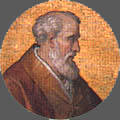 John XIII, like John XII, was a member of the house of
Theophylactus. But except for name and family he had little in common with his
kinsman. John XII might have been called John the Bad; John XIII was called John
the Good.
John XIII, like John XII, was a member of the house of
Theophylactus. But except for name and family he had little in common with his
kinsman. John XII might have been called John the Bad; John XIII was called John
the Good.
John's father, also named John, had married the younger
Theodora, the sister of the famous Marozia. Later he became a bishop. John
himself, quite unlike John XII, was brought up strictly and educated at the
Lateran with the young clerics. He served in the papal chancery, took part in
the condemnation of his relative, John XII, and then in his restoration. With a
reputation for learning and virtue he became papal librarian, then bishop of
Narni. One homely little detail, all too rare in these early biographies, comes
down to us.
John was nicknamed "white hen" on account of his fair hair. John
was not the first choice of the Romans. When Leo VIII died the Romans sent to
the Emperor, asking him to give them back Benedict V; but before this request
could be acted on, Benedict died. Otto sent representatives to Rome to see that
his choice was made pope, and the Emperor's choice was John, bishop of Narni,
who was duly elected. Otto probably thought that in choosing John he was not
only getting a good and reliable pope, but one that would be pleasing to the
Romans. After all, John was of the family of Theophylactus, and Otto hoped that
this would help to reconcile the sensitive Romans to the imperial yoke. But
because he was Otto's choice, the Romans turned against John. A faction led by
Rofred, a Campagna count, and Peter, the city prefect, raised the cry: "Out with
the foreigners!" They seized John and threw him into the Castle of St. Angelo.
Later when he was removed to a castle in the country, John escaped. He fled to
Pandulf of Capua, and after an exile of almost a year made his way back to Rome.
The Romans, learning that Otto was coming, gave the Pope a grand reception. But
Otto was angry, and when he entered the city in August 966, rough German hands
administered bloody justice to the Romans. This brought peace, and for the rest
of his pontificate John had little trouble with the Romans. He got along well
with Otto. On Christmas Day, 967, the Pope crowned his young son Otto II as co-
emperor. John assisted Otto in the marriage negotiations which brought to young
Otto the hand of the beautiful and remarkably able Theophano, young daughter of
the Eastern Emperor Romanus II. John XIII cooperated with the Emperor in
forwarding missionary activity on the frontiers. He confirmed the erection of
Magdeburg as a metropolitan see. The famous diocese of Posen was established for
the Poles in 966. John also backed St. Dunstan in his efforts to reform the
Church in England.
John XIII died peacefully at Rome, September 6, 972. Though
noticeably under Otto's influence, he was a good pope.
Excerpted from "Popes
Through the Ages" by Joseph Brusher, S.J.

